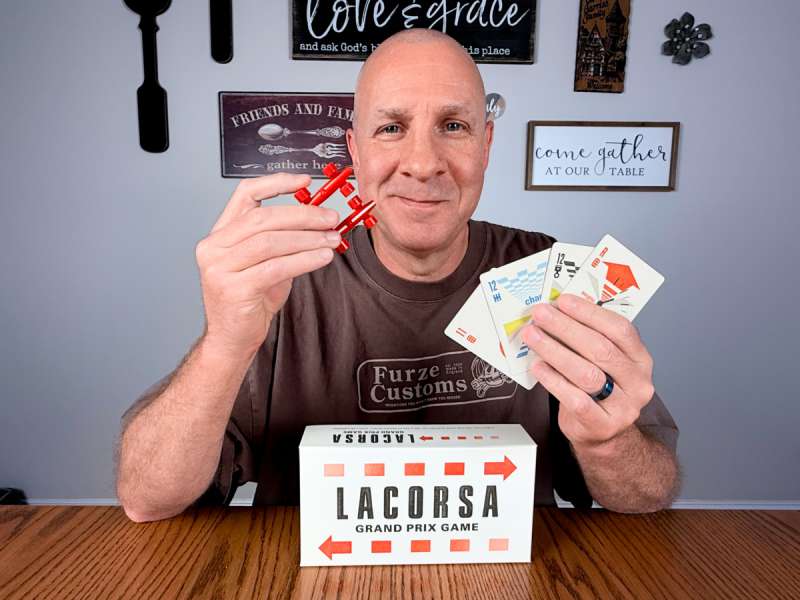
REVIEW – Although the most popular motorsport here in America is NASCAR, the most popular in the world is Formula 1; thus, it’s not surprising that there are over 20 games about racing on Board Game Geek with “Grand Prix” in their title. In this review I’m playtesting Lacorsa Grand Prix, a simple game that focuses on one tactical aspect of Formula 1 racing.
⬇︎ Jump to summary (pros/cons)
Price: $49.00
Where to buy: Lacorsa
What is it?
Lacorsa is a tabletop game about Formula 1 racing for 2 to 6 players. It’s based upon a hand management mechanism and includes an element of bluffing. Lacorsa is an Italian word that means “the race,” and this game attempts to capture “the drama and tactics of Formula 1 racing.”
What’s included?
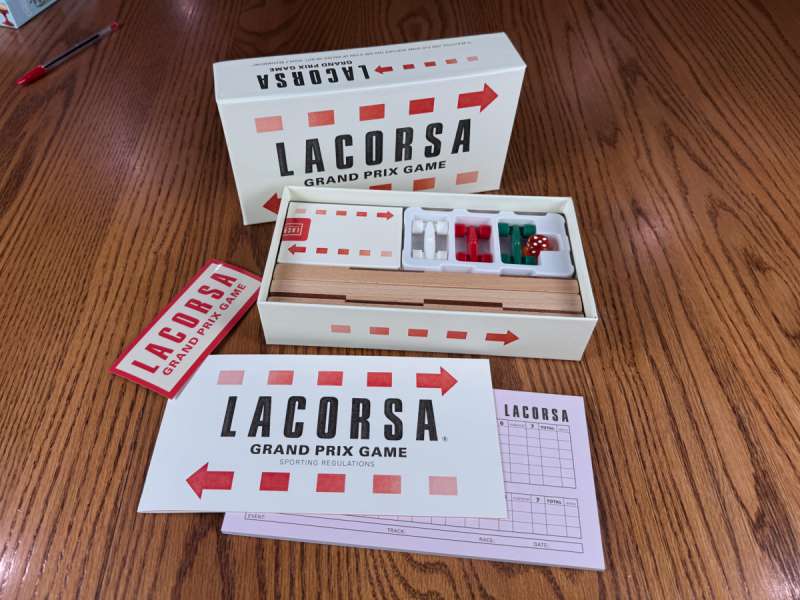
The following items are included:
- 78 playing cards
- 20 marking cards
- 1 board
- 6 race cars
- 1 six-sided die
- 1 scorepad
- 1 rulebook
Theme
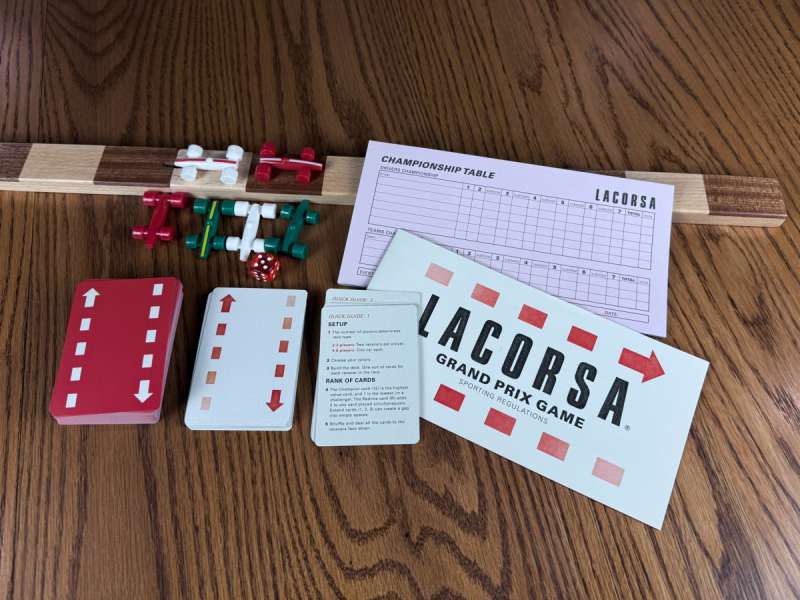
Instead of having cars going around a track, Lacorsa Grand Prix focuses on one particular part of a Formula 1 race: passing the car in front of you. Though rather simplistic, it’s fair to say a grand prix is made of a series of decisions on when to try and pass the car in front while simultaneously trying to prevent the car behind from doing the same. The theme is strong in this game, and the cards dealt to each player reflect the capabilities of their car for this race.
Setup
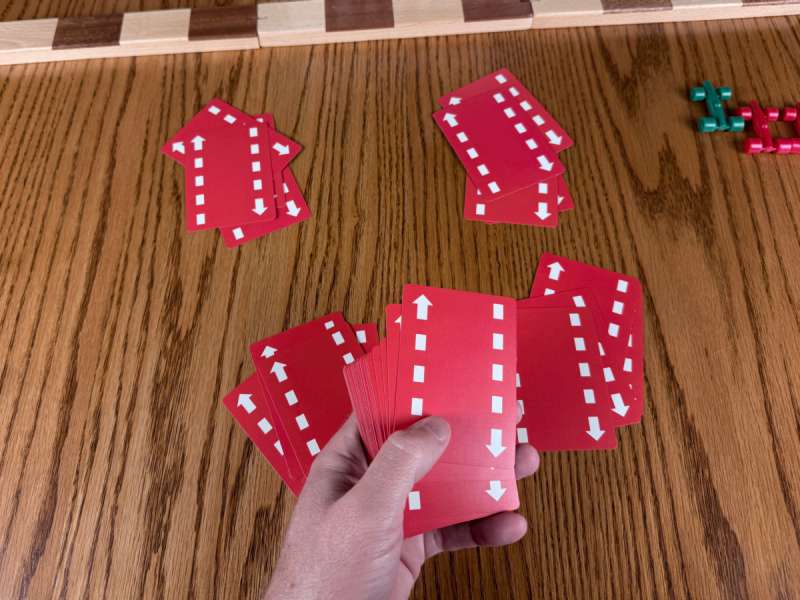
Setup is simple. If there are 2 or 3 players, each takes two cars; if 4 to 6, each takes only one. There are six suits of cards, each numbered 1 to 12 along with an R. Each player selects one suit of cards for each car they have. Neither the suit nor the color of the cards has any bearing upon the game; the number and special ability of a card are the only things that impact game play. The cards are combined into a single deck and shuffled together, then all the cards are dealt out to the players. The board is unfolded and set it in the middle of table; its twelve car-sized spaces represent the section of track that the cars are currently on. The game is ready to begin.
Game Play
There are three parts to this game: strategizing, qualifying, and racing.
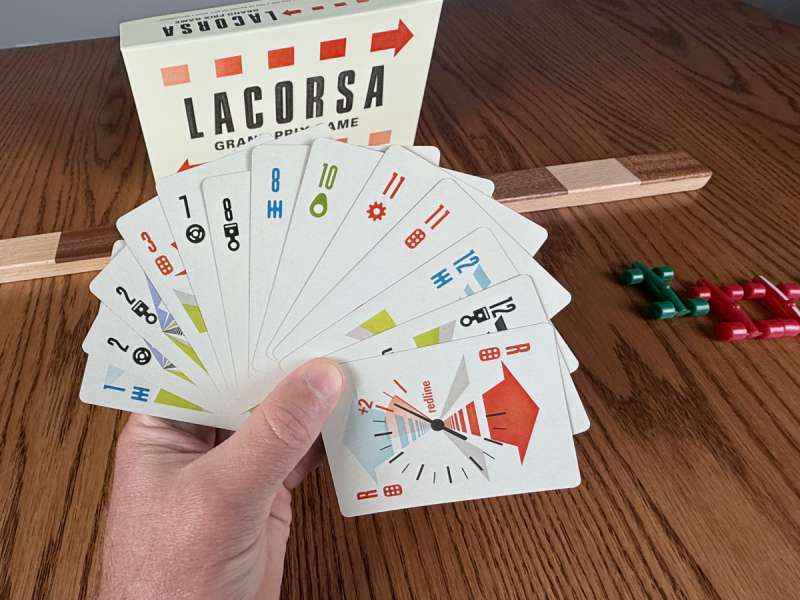
The first part of the game is not in the rule book per se, but it is the most important of the game. As a player looks at the cards that he has been dealt, he must decide what his strategy will be for the game. The cards represent the strengths and weakness of his car for this race, his ability to pass and not be passed, to pull away from other cars and catch up with those ahead. Determining how to run a race with the cards in hand is the real strength of the game, but it’s difficult for new players to understand what strategies are even available, much less which one to take. Lacorsa has a YouTube video where the game designer walks through a mock game; he talks aloud and shares strategy ideas for each deck, a very helpful place to begin understanding strategy. I highly recommend watching this video. BTW, the hand above is a killer hand. I would take the pole position, defend one challenge, then extend and never look back. That should be an easy victory.
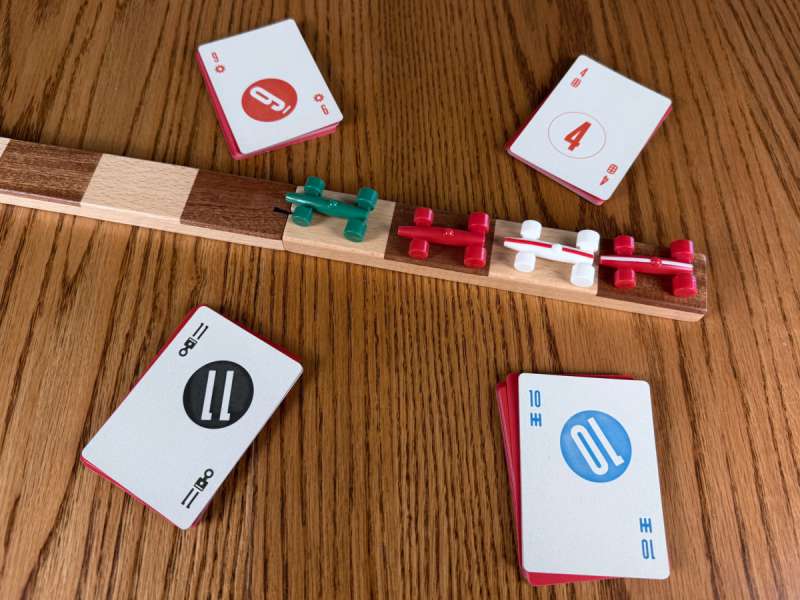
The second part of the game is qualifying. To qualify, each player secretly selects a card, places it on top of his deck, and sets his deck face down. Once everyone has done this, the top cards are simultaneously revealed. The lowest card starts in the back of the pack and is placed at one end of the track. The remaining cars are placed on the track from lower to higher numbers, until the car for the highest player is placed in front at the pole position. The cards used for qualifying are discarded. Starting in front is a big advantage, as it is in an actual Formula 1 race, but it comes at the cost of expending a higher card. The more players, the bigger this advantage is.
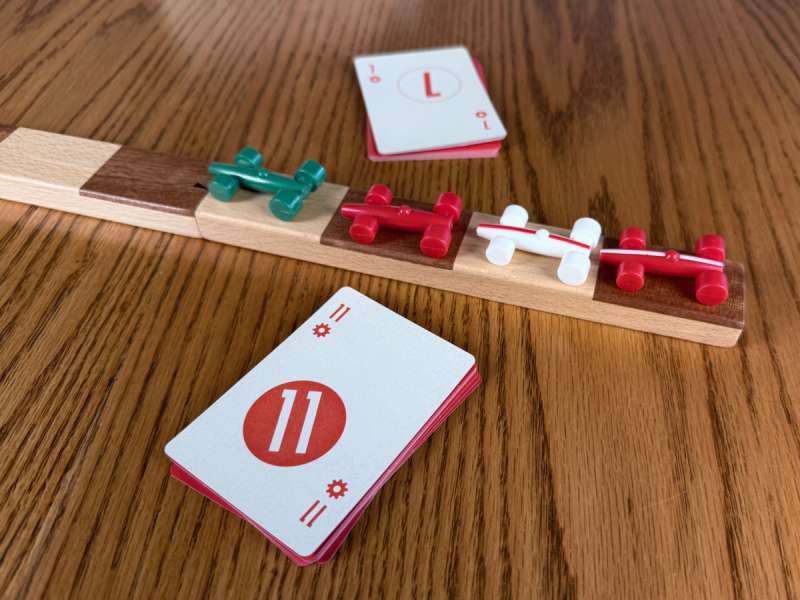
The third part of the game is racing, and it’s all about trying to pass. The car in the back challenges the car in front of him. The challenger and the challenged both secretly select a card, places it on top of their decks, and sets their decks down. Once both players are ready, they simultaneously reveal their top card. If the card of the challenging card is higher, his car successfully passes, and their cars swap places on the track. The cards used for challenging are discarded. The challenger can then challenge the next car and try to move up another position. If the challenge fails, then the car that was challenged becomes the challenger and attempts to pass the car in front of him. This continues all the way up to lead car. Once the final challenge is over, the lead car has the opportunity to extend his lead. Once this is done, one lap in the race is complete. At point, the game is in a loop. Play returns to the car at the back of the pack, who once again challenges the car in front of him and so forth. This loop is played again and again until the end game condition is reached.
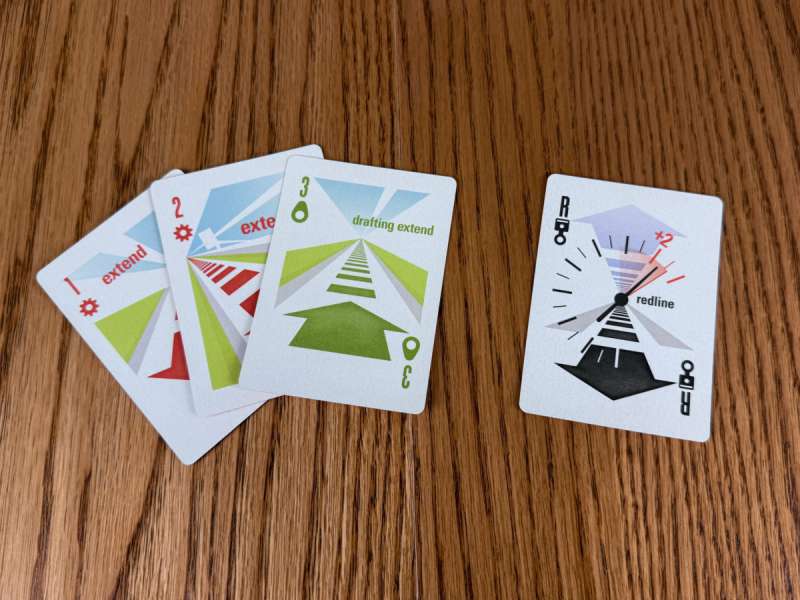
Most of the cards simply have a face value, and higher numbers are better. There are two types of cards that have special abilities:
- The 1, 2, and 3 cards can be used by a player to put an extra space between his car and the car behind him, or they can be used to catch up to a car who is an extra space ahead.
- The R card, which stands for redline, can be combined with another card to increase its value; it’s like a burst of speed.
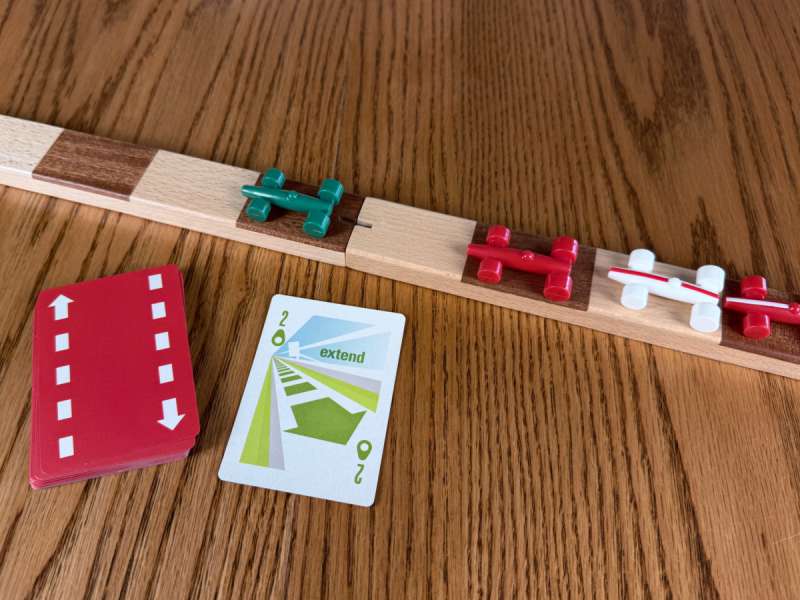
This is a definitely a hand management game. The trick is knowing when to play a powerful card from the limited supply of cards in the hand. Should I play a high-numbered card now and pass the car in front of me, or should I hold onto it to block a challenge later? The game also has a bluffing element, as each player must attempt to discern what card the other player will be playing and thus what card to counter with. Players can’t do everything they want to do, so they must be tactically smart when choosing which card to lay at any given moment.
End Game
The end game condition is reached when one player runs out of cards. The rest of the lap is finished, and then the race is over. We found that the race took around six laps whether we four or six players.
Points are assigned for the position finished. Like all card games, Lacorsa Grand Prix has a high element of luck. If a player is dealt a weak hand, he will struggle to win the race, no matter how cleverly he plays his cards. This is undoubtedly why one complete game consists of seven races played back-to-back that collectively form a championship. The results of each race are tallied on the scorepad, and the winner is the player with the most points for the championship. Each race takes less than ten minutes to play, so a championship can be played in about an hour.
Game Quality
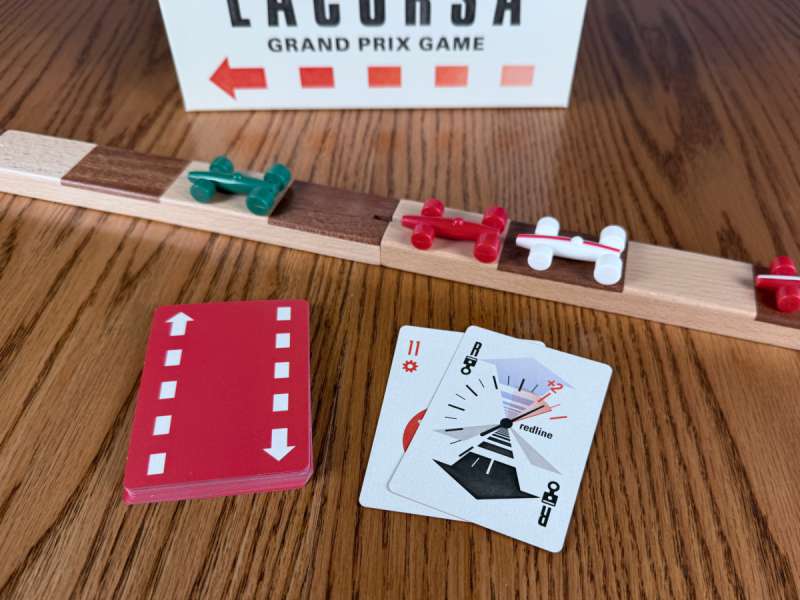
The track is attractive and made of wood; the cars are sadly just plastic. The cards are of acceptable quality, and the artwork is sufficient if simplistic. The box is quite sturdy and holds everything cozily in place. The game is priced at $50, a very expensive price for the items in the box. I would expect this game to be $30 or less.
I was disappointed by the Rulebook. As I read through the rules, I often had questions that were unanswered, such as:
- “Why are there two sets of orange and black cards but only one set of green and blue cards?”
- “Why are there different suits?”
- “If two cars are on the same team, does the car behind have to challenge the one ahead?”
- “Why would a car be left unchallenged?”
Some of my questions were answered later in the Rulebook, but others, such as “Do I discard the card I used for qualifying?”, were not answered until I read through the Quick Start version of the rules. This means that some of the game rules are only in the Quick Start, a serious oversight. Given how simple this game is and how short the Rulebook is, Lacorsa doesn’t need a Quick Start. I think they should combine all the rules into one set of rules and rewrite them to carefully include all the questions that a first-time player might have; play-testing with new players should reveal those rules that the designers know but newbies don’t. The manual should also include a section on the basics of strategy, a critical part of this game that is completely missing from the manual. You can read the Rulebook for yourself here and the Quick Start guide here; there’s also a solo variant whose rules are here.
Final Thoughts
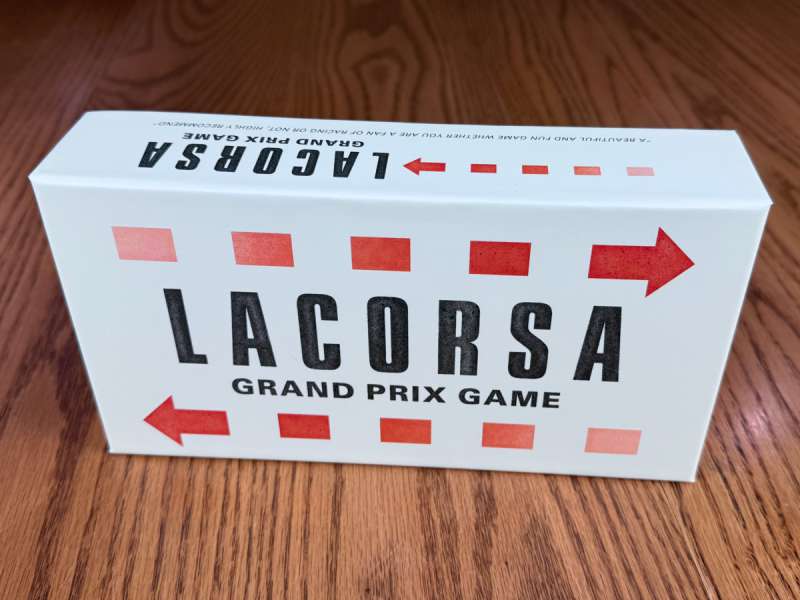
While Corsaco does not emulate a complete Formula 1 race, it does capture the most critical part of racing – knowing when to pass – very well, and I like this aspect of the game. The theme is strong with this game: It feels like you’re racing. Strong starts, unexpected passes, last second victories; it’s all in the game.
The rules are simple, but there’s more complexity to this game than expected; the key is knowing when to play what cards.
The high level of luck means that some races are a lot of fun! You have all the right cards to pass the cars in front of you and pull ahead. It also means that some races not fun; you can’t win with bad cards, no matter how good of a player you are. (I think that this is actually a design flaw in this game, as a well-designed game always gives you a chance to win.) To be fair, the element of luck is mitigated by having to play seven races.
The biggest weakness of the game is that it lacks replayability. With very little variety in the game, it’s too repetitious. We are supposed to play seven races in one sitting for a championship, but it’s not fun enough to do the same thing so many times. We never played more than three races during a gaming session. I suspect that Lacorsa is one of those games that we will take off the shelf only once or twice a year.
Lacorsa offers several expansions to the game, and each adds new cars along with “a new Track Card that introduces a unique rule variant.” I don’t have any of these expansions, so I don’t know how much they change the game. It would be cool if each expansion offers a unique rule for each car. It’s possible that these expansions provide the much-needed variation to improve replayability.
The best board games allow players to interact with each other in some way, even when it’s not their turn. (Think trading resources in Catan.) In Corsica, only two players are playing at any point in the game, while everyone else sits and watches. This is not ideal, but at least the turns are short and downtime is minimal.
The bluffing element of the game is well done. You’re constantly having to evaluate your opponent, guess at what cards they have remaining, and trying to decide if you should play a better or worse card.
This is a good game for families, as it allows children to join in the play. Sure, younger children might not understand all of tactics of when to play the optimal card, but they can always play a card and thus join in the family fun. We tested with a 10-year-old and an 8-year-old; both were more than capable of understanding the rules and knowing when to select good cards.
My wife and I played this game together, but we did not enjoy it as a two-player game. When I control two cars, most laps get to the point where one of my cars is supposed to challenge the other of my cars. In a real Formula 1 race, these drivers would duke it out; in Lacorsa, however, this challenge is pointless and would only waste cards. Every time this happened, I simply discarded my two weakest cards. That’s no fun and reflects another design flaw in the game. We had a lot more fun playing with four and six players.
Our gaming groups had two suggestions for improving the game:
- Add one or more game mechanisms that reduces luck. One way might be to give each player a fixed number of cards from their suit and mix and shuffle the others. Another way might be to give each player one or more fixed cards. For example, every player could get one card called “Block” that could be used one time during a race to automatically prevent the car behind him from passing.
- Work out a deal with Hot Wheels to include their Formula 1 racing cars and get rid of the plastic cars. Obviously, this is just a visual upgrade, but it would be appealing.
What I like about Lacorsa Grand Prix
- Formula 1 racing
- Realistic tactics for passing
- Excellent use of bluffing to outplay opponents
What needs to be improved?
- Decrease the amount of luck in the game
- Increase the variability between games
- Merge the Quick Start into the Rulebook.
- Lower the price
Price: $49
Where to buy: Lacorsa
Source: The sample for this review was provided free of charge by Lacorsa. Lacorsa did not have a final say on the review and did not preview the review before it was published.
Check out these other game reviews!
- District Noir card game review – a light yet fun game for two players
- Play Easily Now (PEN) Wargame – lots of fun with your (mini) figures
- PlayMonster 5 Second Rule party game review


